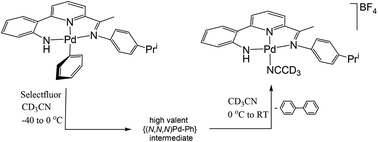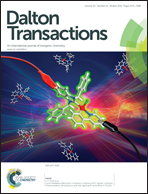Organo-palladium(ii) complexes bearing unsymmetrical N,N,N-pincer ligands: synthesis, structures and oxidatively induced coupling reactions†
Abstract
The 2-(2′-aniline)-6-imine-pyridines, 2-(C6H4-2′-NH2)-6-(CMe![[double bond, length as m-dash]](https://www.rsc.org/images/entities/char_e001.gif) NAr)C5H3N (Ar = 4-i-PrC6H4 (HL1a), 2,6-i-Pr2C6H3 (HL1b)), have been synthesised via sequential Stille cross-coupling, deprotection and condensation steps from 6-tributylstannyl-2-(2-methyl-1,3-dioxolan-2-yl)pyridine and 2-bromonitrobenzene. The palladium(II) acetate N,N,N-pincer complexes, [{2-(C6H4-2′-NH)-6-(CMe
NAr)C5H3N (Ar = 4-i-PrC6H4 (HL1a), 2,6-i-Pr2C6H3 (HL1b)), have been synthesised via sequential Stille cross-coupling, deprotection and condensation steps from 6-tributylstannyl-2-(2-methyl-1,3-dioxolan-2-yl)pyridine and 2-bromonitrobenzene. The palladium(II) acetate N,N,N-pincer complexes, [{2-(C6H4-2′-NH)-6-(CMe![[double bond, length as m-dash]](https://www.rsc.org/images/entities/char_e001.gif) NAr)C5H3N}Pd(OAc)] (Ar = 4-i-PrC6H4 (1a), 2,6-i-Pr2C6H3 (1b)), can be prepared by reacting HL1 with Pd(OAc)2 or, in the case of 1a, more conveniently by the template reaction of ketone 2-(C6H4-2′-NH2)-6-(CMe
NAr)C5H3N}Pd(OAc)] (Ar = 4-i-PrC6H4 (1a), 2,6-i-Pr2C6H3 (1b)), can be prepared by reacting HL1 with Pd(OAc)2 or, in the case of 1a, more conveniently by the template reaction of ketone 2-(C6H4-2′-NH2)-6-(CMe![[double bond, length as m-dash]](https://www.rsc.org/images/entities/char_e001.gif) O)C5H3N, Pd(OAc)2 and 4-isopropylaniline; ready conversion of 1 to their chloride analogues, [{2-(C6H4-2′-NH)-6-(CMe
O)C5H3N, Pd(OAc)2 and 4-isopropylaniline; ready conversion of 1 to their chloride analogues, [{2-(C6H4-2′-NH)-6-(CMe![[double bond, length as m-dash]](https://www.rsc.org/images/entities/char_e001.gif) NAr)C5H3N}PdCl] (Ar = 4-i-PrC6H4 (2a), 2,6-i-Pr2C6H3 (2b)), has been demonstrated. The phenyl-containing complexes, [{2-(C6H4-2′-NH)-6-(CMe
NAr)C5H3N}PdCl] (Ar = 4-i-PrC6H4 (2a), 2,6-i-Pr2C6H3 (2b)), has been demonstrated. The phenyl-containing complexes, [{2-(C6H4-2′-NH)-6-(CMe![[double bond, length as m-dash]](https://www.rsc.org/images/entities/char_e001.gif) NAr)C5H3N}PdPh] (Ar = 4-i-PrC6H4 (3a), 2,6-i-Pr2C6H3 (3b)), can be obtained by treating HL1 with (PPh3)2PdPh(Br) in the presence of NaH or with regard to 3a, by the salt elimination reaction of 2a with phenyllithium. Reaction of 2a with silver tetrafluoroborate or triflate in the presence of acetonitrile allows access to cationic [{2-(C6H4-2′-NH)-6-(CMe
NAr)C5H3N}PdPh] (Ar = 4-i-PrC6H4 (3a), 2,6-i-Pr2C6H3 (3b)), can be obtained by treating HL1 with (PPh3)2PdPh(Br) in the presence of NaH or with regard to 3a, by the salt elimination reaction of 2a with phenyllithium. Reaction of 2a with silver tetrafluoroborate or triflate in the presence of acetonitrile allows access to cationic [{2-(C6H4-2′-NH)-6-(CMe![[double bond, length as m-dash]](https://www.rsc.org/images/entities/char_e001.gif) N(4-i-PrC6H4)C5H3N}Pd(NCMe)][X] (X = BF4 (4), X = O3SCF3 (5)), respectively; the pyridine analogue of 5, [{2-(C6H4-2′-NH)-6-(CMe
N(4-i-PrC6H4)C5H3N}Pd(NCMe)][X] (X = BF4 (4), X = O3SCF3 (5)), respectively; the pyridine analogue of 5, [{2-(C6H4-2′-NH)-6-(CMe![[double bond, length as m-dash]](https://www.rsc.org/images/entities/char_e001.gif) N(4-i-PrC6H4)C5H3N}Pd(NC5H5)][O3SCF3] (5′), is also reported. Oxidation of phenyl-containing 3a with one equivalent of 1-chloromethyl-4-fluoro-1,4-diazoniabicyclo[2.2.2]octane bis(tetrafluoroborate) (Selectfluor™) in acetonitrile at low temperature leads to a new palladium species that slowly decomposes to give 4 and biphenyl; biphenyl formation is also observed upon reaction of 3a with XeF2. However, no such oxidatively induced coupling occurs when using 3b. Single crystal X-ray diffraction studies have been performed on HL1b, 1a, 1b, 2a, 2b, 3a, 3b and 5′.
N(4-i-PrC6H4)C5H3N}Pd(NC5H5)][O3SCF3] (5′), is also reported. Oxidation of phenyl-containing 3a with one equivalent of 1-chloromethyl-4-fluoro-1,4-diazoniabicyclo[2.2.2]octane bis(tetrafluoroborate) (Selectfluor™) in acetonitrile at low temperature leads to a new palladium species that slowly decomposes to give 4 and biphenyl; biphenyl formation is also observed upon reaction of 3a with XeF2. However, no such oxidatively induced coupling occurs when using 3b. Single crystal X-ray diffraction studies have been performed on HL1b, 1a, 1b, 2a, 2b, 3a, 3b and 5′.


 Please wait while we load your content...
Please wait while we load your content...